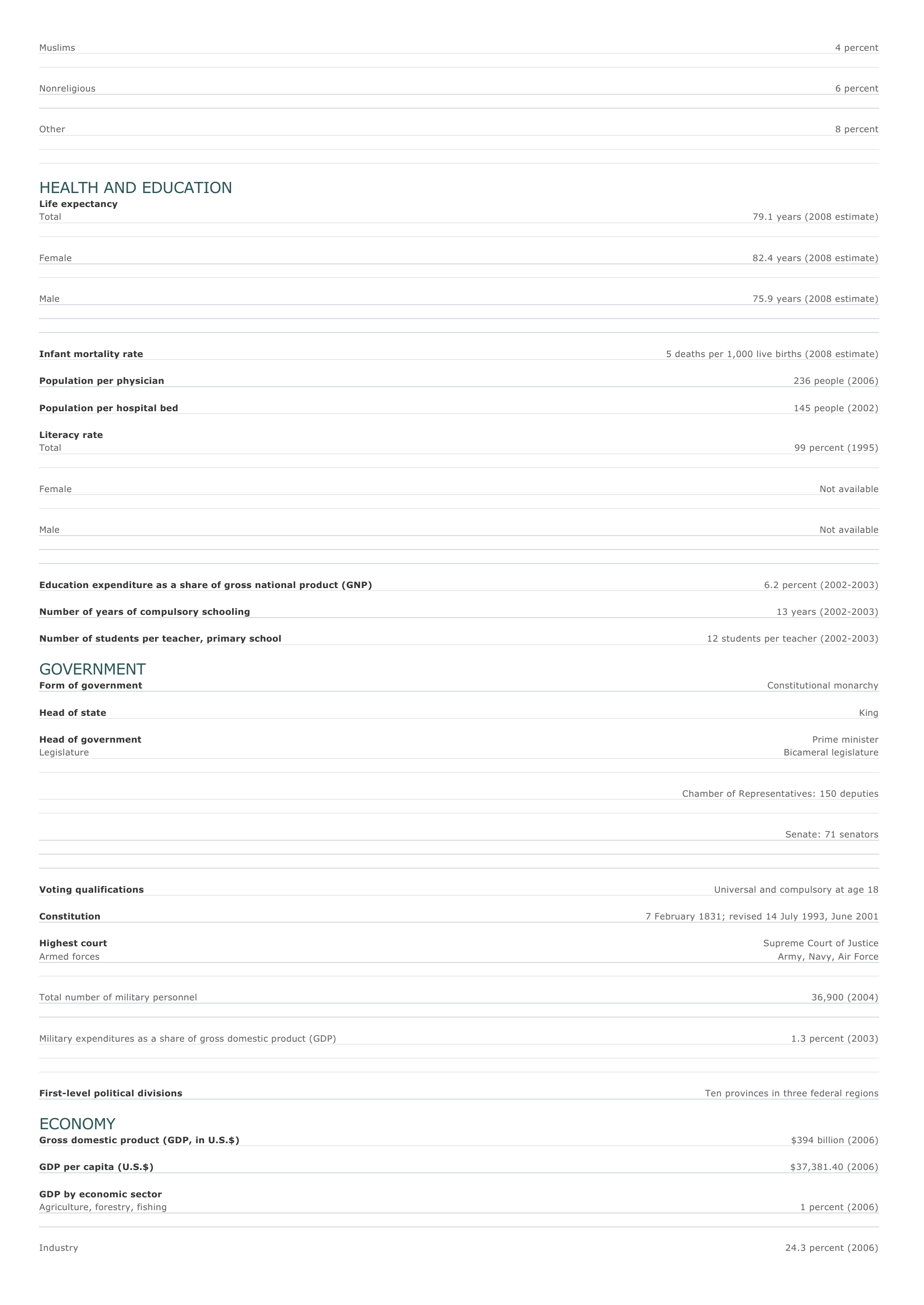Belgium Facts and Figures. BASIC FACTS Official name Capital Area Kingdom of Belgium Brussels 30,528 sq km 11,787 sq mi PEOPLE Population 10,403,951 (2008 estimate) Population growth Population growth rate 0.11 percent (2008 estimate) Projected population in 2025 10,453,261 (2025 estimate) Projected population in 2050 9,882,599 (2050 estimate) Population density Urban/rural distribution Share urban Share rural 344 persons per sq km (2008 estimate) 890 persons per sq mi (2008 estimate) 97 percent (2005 estimate) 3 percent (2005 estimate) Largest cities, with population Brussels 1,031,215 (2007 estimate) A ntwerp 466,203 (2007 estimate) G hent 235,143 (2007 estimate) Charleroi 201,550 (2007 estimate) Liège 188,907 (2007 estimate) Ethnic groups Flemish 55 percent Walloon 33 percent Mixed or other 12 percent Languages Dutch (official) 56 percent French (official) 32 percent German (official) 1 percent Legally bilingual (divided along ethnic lines) 11 percent Religious affiliations Roman Catholic 81 percent Protestant 1 percent Muslims 4 percent Nonreligious 6 percent O ther 8 percent HEALTH AND EDUCATION Life expectancy Total 79.1 years (2008 estimate) Female 82.4 years (2008 estimate) Male 75.9 years (2008 estimate) Infant mortality rate 5 deaths per 1,000 live births (2008 estimate) Population per physician 236 people (2006) Population per hospital bed 145 people (2002) Literacy rate Total 99 percent (1995) Female Not available Male Not available Education expenditure as a share of gross national product (GNP) Number of years of compulsory schooling Number of students per teacher, primary school 6.2 percent (2002-2003) 13 years (2002-2003) 12 students per teacher (2002-2003) GOVERNMENT Form of government Head of state Head of government Legislature Constitutional monarchy King Prime minister Bicameral legislature Chamber of Representatives: 150 deputies Senate: 71 senators Voting qualifications Constitution Highest court Armed forces Total number of military personnel Military expenditures as a share of gross domestic product (GDP) First-level political divisions Universal and compulsory at age 18 7 February 1831; revised 14 July 1993, June 2001 Supreme Court of Justice Army, Navy, Air Force 36,900 (2004) 1.3 percent (2003) Ten provinces in three federal regions ECONOMY Gross domestic product (GDP, in U.S.$) $394 billion (2006) GDP per capita (U.S.$) $37,381.40 (2006) GDP by economic sector Agriculture, forestry, fishing I ndustry 1 percent (2006) 24.3 percent (2006) Services Employment Number of workers 74.7 percent (2006) 4,537,267 (2006) Workforce share of economic sector Agriculture, forestry, fishing 2 percent (2004) I ndustry 25 percent (2004) Services 73 percent (2004) Unemployment rate 7.4 percent (2004) National budget (U.S.$) Total revenue $162,169 million (2006) Total expenditure $163,062 million (2006) Monetary unit* 1 euro (EUR), consisting of 100 cents *The Belgian franc (BF) became linked to the EU single currency, the euro (EUR), on 1 January 1999 at a fixed rate of 40.3399 to 1 euro (EUR). Euro coins and bills replaced the Belgian franc as the national currency on January 1, 2002. Agriculture Sugar beets, potatoes, wheat, barley, pork, beef, dairy products Manufacturing Metal products, motor vehicle assembly, food processing, chemicals, metals, textiles Major exports Automobiles, food and food products, iron and steel, diamonds, textiles, plastics, petroleum products, nonferrous metals Major imports Food products, machinery, rough diamonds, petroleum and petroleum products, chemicals, clothing and accessories, textiles Major trade partners for exports Germany, France, Netherlands, United Kingdom, United States Major trade partners for imports Germany, Netherlands, France, United Kingdom, Ireland ENERGY, COMMUNICATIONS, AND TRANSPORTATION Electricity production Electricity from thermal sources Electricity from hydroelectric sources Electricity from nuclear sources Electricity from geothermal, solar, and wind sources 40.44 percent (2003 estimate) 0.30 percent (2003 estimate) 57.14 percent (2003 estimate) 2.11 percent (2003 estimate) Number of radios per 1,000 people 797 (1997) Number of telephones per 1,000 people 461 (2004) Number of televisions per 1,000 people 537 (2000 estimate) Number of Internet hosts per 10,000 people 203 (2003) Daily newspaper circulation per 1,000 people 160 (1996) Number of motor vehicles per 1,000 people Paved road as a share of total roads 529 (2004) 78 percent (2004) SOURCES Basic Facts and People sections Area data are from the statistical bureaus of individual countries. Population, population growth rate, and population projections are from the United States Census Bureau, International Programs Center, International Data Base (IDB) (www.census.gov). Urban and rural population data are from the Food and Agriculture Organization (FAO) of the United Nations (UN), FAOSTAT database (www.fao.org). Largest cities population data and political divisions data are from the statistical bureaus of individual countries. Ethnic divisions and religion data are largely from the latest Central Intelligence Agency (CIA) World Factbook and from various country censuses and reports. Language data are largely from the Ethnologue, Languages of the World, Summer Institute of Linguistics International (www.sil.org). Health and Education section Life expectancy and infant mortality data are from the United States Census Bureau, International Programs Center, International database (IDB) (www.census.gov). Population per physician and population per hospital bed data are from the World Health Organization (WHO) (www.who.int). Education data are from the United Nations Educational, Scientific and Cultural Organization (UNESCO) database (www.unesco.org). Government section Government, independence, legislature, constitution, highest court, and voting qualifications data are largely from various government Web sites, the latest Europa World Yearbook, and the latest Central Intelligence Agency (CIA) World Factbook. The armed forces data is from Military Balance. Economy section Gross domestic product (GDP), GDP per capita, GDP by economic sectors, employment, and national budget data are from the World Bank database (www.worldbank.org). Monetary unit, agriculture, mining, manufacturing, exports, imports, and major trade partner information is from the statistical bureaus of individual countries, latest Europa World Yearbook, and various United Nations and International Monetary Fund (IMF) publications. Energy, Communication, and Transportation section Electricity information is from the Energy Information Administration (EIA) database (www.eia.doe.gov). Radio, telephone, television, and newspaper information is from the United Nations Educational, Scientific and Cultural Organization (UNESCO) database (www.unesco.org). Internet hosts, motor vehicles, and road data are from the World Bank database (www.worldbank.org). Note Figures may not total 100 percent due to rounding. Microsoft ® Encarta ® 2009. © 1993-2008 Microsoft Corporation. All rights reserved.


